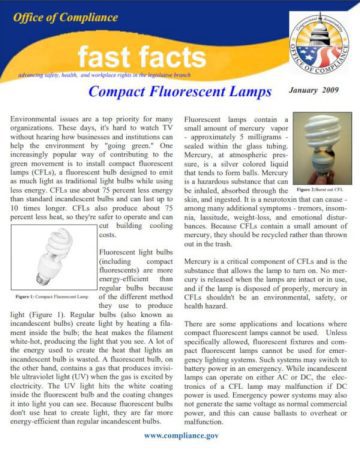Environmental issues are a top priority for many organizations. These days, it’s hard to watch TV without hearing how businesses and institutions can help the environment by “going green.” One increasingly popular way of contributing to the green movement is to install compact fluorescent lamps (CFLs), a fluorescent bulb designed to emit as much light as traditional light bulbs while using less energy. CFLs use about 75 percent less energy than standard incandescent bulbs and can last up to 10 times longer. CFLs also produce about 75 percent less heat, so they’re safer to operate and can cut building cooling costs.
Fluorescent light bulbs (including compact fluorescents) are more energy-efficient than regular bulbs because of the different method they use to produce light (Figure 1). Regular bulbs (also known as incandescent bulbs) create light by heating a filament inside the bulb; the heat makes the filament white-hot, producing the light that you see. A lot of the energy used to create the heat that lights an incandescent bulb is wasted. A fluorescent bulb, on the other hand, contains a gas that produces invisible ultraviolet light (UV) when the gas is excited by electricity. The UV light hits the white coating inside the fluorescent bulb and the coating changes it into light you can see. Because fluorescent bulbs don’t use heat to create light, they are far more energy-efficient than regular incandescent bulbs.
Fluorescent lamps contain a small amount of mercury vapor approximately 5 milligrams – sealed within the glass tubing. Mercury, at atmospheric pressure, is a silver colored liquid that tends to form balls. Mercury is a hazardous substance that can be inhaled, absorbed through the skin, and ingested. It is a neurotoxin that can cause – among many additional symptoms – tremors, insomnia, lassitude, weight-loss, and emotional disturbances. Because CFLs contain a small amount of mercury, they should be recycled rather than thrown out in the trash.

